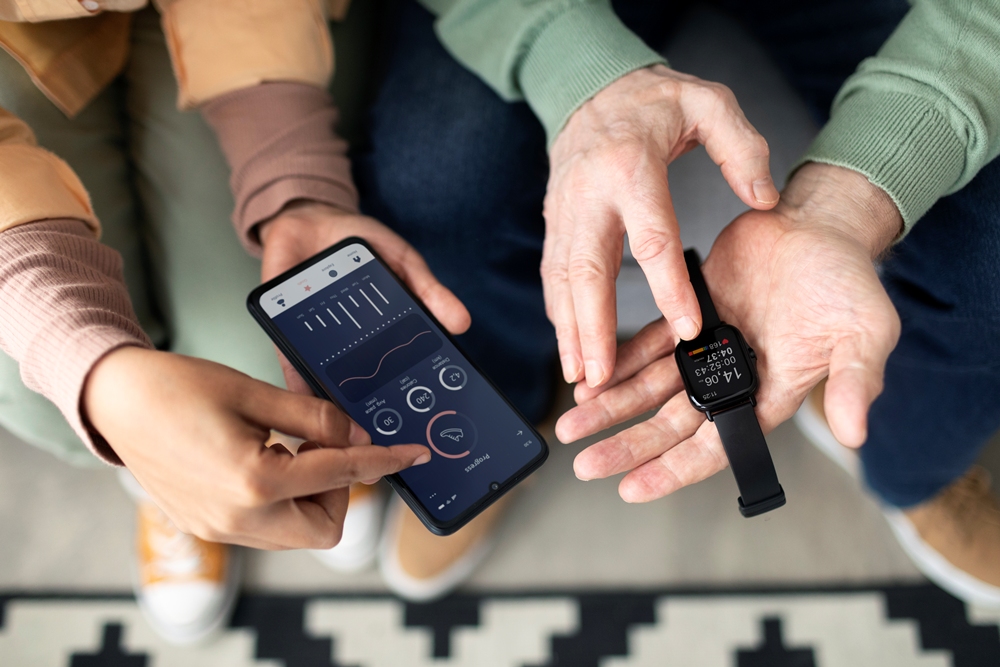
Digital health tools have the potential to revolutionise healthcare by making it more affordable, personalised and efficient than ever before.
However, the technology also risks deepening existing inequalities.
Here, Health Tech World and Femtech World members share their views on how digital health can be a driver of inclusion rather than division.
Chip Parkinson, CEO, GiftHealth:
“Equity in digital health isn’t achieved by tech alone.
“It comes from intentionally designing systems that combine automation with human empathy.
“The future isn’t high-tech or high-touch, it’s both, working together to ensure no patient is left behind.”
Dr Rachael Grimaldi, co-founder and chief medical officer, CardMedic
“Making sure digital health tools help everyone, and don’t leave people behind, means designing them with inclusivity as a top priority. We need to focus on people who have been historically underserved right from the start.
“To do this, we should work with healthcare professionals, patients and communities to build solutions together.
“This helps us tackle common barriers like differences in language, literacy, or culture.”
Dr Harry Thirkettle, head of health innovation at Aire Logic
“Ensuring digital health tools genuinely help everyone, rather than just a select few, means tackling the issue of digital poverty head-on.
“This is about more than just a lack of devices, it’s also about poor connectivity or a simple lack of digital skills.
“To truly make a difference, we need to focus on purpose-driven initiatives and partnerships that deliver a real, measurable impact.”
Sharon Hanley, director of primary care, X-on Health
“We must ensure that digital health tools are designed with inclusion at their core.
“That means recognising the diverse range of barriers that patients face, including language, digital confidence, working patterns, or access to devices, and offering multiple, flexible ways to engage with care, including the use of voice-enabled tools.
“True equity isn’t about pushing everyone down one digital path.
“It’s about creating a system where every patient, regardless of background or circumstance, can access the support they need in a way that works for them.”
Duong Tu, director, sales and marketing, cardiac rhythm management diagnostics and RhythmCARE, EMEA at Boston Scientific
“At Boston Scientific, we see digital health not just as a technological evolution, but as a powerful catalyst for inclusion.
“Our vision is to make care more predictive, personalised and participative, so that every patient, regardless of geography or background, can benefit from timely, high-quality treatment.
“We believe the future of healthcare is one where innovation uplifts everyone.
“By designing digital tools that prioritise equity, education and engagement, we’re helping to build a system that’s not only smarter – but fairer.”
Kath Dean, president, Cloud21
“True transformation should include conversations around co-design with frontline staff and communities that will help to embed usability and accessibility, so tools are inclusive for people with varying digital literacy.
“By capturing essential information once and reusing it across pathways, we can reduce administrative burden and give clinicians more time with patients.
“Crucially, investment should look to prioritise outcomes by evaluating whether digital tools help reach underserved groups, enable earlier prevention, and deliver measurable improvements in care.”
Dr Eleanor Wicks, co-founder, Lifeyear
“If the NHS 10 Year Plan is to succeed, it must succeed with CVD – where digital tools can have the greatest impact on inequality.
“Too many patients, especially those with heart failure, fall through gaps after hospital discharge; digital pathways can ensure seamless care across acute, community and primary settings.
“Digital risk assessment, prompts and personalised interventions can help target high-risk groups and digital transformation in CVD is essential to build proactive, connected, sustainable and equitable care.”
Chris Scarisbrick, UK and Ireland deputy managing director, Sectra
“Narrowing healthcare inequalities sits at the heart of the agenda in many large digital diagnostic initiatives in the NHS.
“Having equity so central in such programmes, remains extremely important as complex networks of trusts collaborate to share diagnostic expertise across organisational boundaries.
“Imaging platforms or digital pathology might be the labels that identify programmes, but the NHS imaging networks, cancer alliances, collaboratives, and ICBs we support have never lost sight of the fact that improving access to highly demanded clinical insight is fundamental.”
John Romano, president & co-founder, GiftHealth
“To truly reduce health disparities, digital health must start by understanding where traditional systems fail.
It’s not just about convenience, it’s about reimagining access, especially for patients who’ve been historically underserved.
“When tech is built to bridge those gaps, not just digitize old workflows, we create real impact.”
Graham Bennett, business alliance director, Insource
“Tackling health inequalities is one of the many challenges facing the NHS, alongside prevention and reducing waiting lists, to name just a few.
“The issues are varied and urgent, but they all share a common starting point: data.
“Data-driven insights are essential to solving these issues, but that analysis will only be as good as the evidence behind it.
“Without accurate, complete and reliable information, analysis is assumptive and the resultant actions less effective.
“Giving the NHS access to validated, integrated data from across care settings provides the solid foundation needed for robust analysis of patient cohorts.”
Annie Theriault, managing partner, Cross-Border Impact Ventures
“At CBIV, we believe digital health must be designed for all—starting with clinical research that reflects gender and racial diversity, and scaling transformative technologies that are locally validated and globally relevant.”
Josh Miller, CEO, Gradient Health
“AI in healthcare is only as good as the data it is trained on.
“If we rely solely on data from academic institutions, we risk building systems that overlook patients in rural or less privileged communities.
“By ensuring training data truly reflects humanity, AI can reduce inequalities rather than reinforce them.”
Neil Stevens, managing director, Predictive Health Intelligence
“Contrary to conventional wisdom, our research shows that people in the most deprived areas often have more health data on record, yet they are less likely to receive timely specialist care and more likely to present with advanced disease.
“By using digital health tools like hepatoSIGHT, we are helping the NHS identify these patients earlier and proactively close this gap in access, helping to improve the health of the population.”
Przemek Grzywa, co-founder and co-CEO, Revolve Healthcare
“Involving patients in the design process remains fundamental for digital health solutions to have an impact on inequalities.
“If the solution is to make a tangible difference to people’s lives, health technology providers must understand lived experience.
“This co-design element is key if we are to foster patient empowerment through technology, and ensure that they can narrow healthcare inequalities – a topic high on the UK healthcare agenda.”
Professor Hamish Laing, non-executive director at Life Sciences Hub Wales and chair of Digital Inclusion Alliance Wales
“We know that being older, poorer, less well educated, having a long-term illness or disability makes digital exclusion much more likely and yet those citizens are the biggest users of healthcare and so could benefit most from digital tools, especially if they also live rurally.
“So digital tech has to be easier to use through genuine user-centred design; affordable with optimised data requirements; run on older devices and meet actual user needs by engaging with them to find out what those are (“pull” not “push” innovation).”
By Afshin Attari, director of public sector at Exponential-e
“Ultimately, reducing health inequalities through digital tools comes down to ease of use, data integrity, governance, and design.
“Poor-quality or biased data risks reinforcing existing disparities, while seamless interactive, clean, secure, and well-managed data creates a foundation for equity.
“Real-time insights can help spot and address gaps before they become systemic issues.
“Done right, AI via digital health platforms can act as a liberating force, helping clinicians spend less time on process and more focus on people, ensuring that every type of patient receives care that is both efficient, effective and compassionate.”
Shane McNamee, industry lead of global public health at Appian
“When digital health tools are built on unified data and intelligent automation, they do more than improve efficiency – they extend equity.
“They allow health systems to meet patients where they are, reduce the risk of exclusion, and ensure that technology supports, rather than replaces, the human connection at the heart of care.
“Inclusion isn’t a feature to add later; it’s the principle that must shape the digital foundations of healthcare to drive access and inclusivity at scale.”
Dr Mikael Kågebäck, chief technology officer, Sleep Cycle
“Too many digital health tools still rely on costly wearables or specialised devices, which risks leaving out those who can’t afford them.
“The real opportunity lies in utilising technology that most people already have, such as smartphones, to deliver advanced health insights.
“By starting with sleep, people can utilise our technology to understand and improve one of the most fundamental aspects of their health, all without the need for additional devices or effort.”
Hemal Somaiya, chief strategy officer of PharmaForceIQ
“As the policy landscape shifts, more patients are at risk of falling through the cracks in the existing system and via traditional pharma marketing channels – despite critical needs for treatment.
“Now, real-world data-driven audience targeting and deployment strategies can help reach the right HCPs and patients efficiently to ensure sustained treatment access and reduce inequality.
“Using real clinical signals from a broad range of organisations, including primary care, specialist practices, community hospitals, academic medical centres, and FQHCs, ensures all encounters and HCPs are being captured – not just high-prescribers that pharma has traditionally targeted that mean leaving out many patient populations.”
Nicholas Appelbaum, CEO and co-founder of Dosium
“While much of the discussion on health inequalities centres on patient access and digital exclusion, we often overlook how the digital tools powering our healthcare systems can themselves contribute to these disparities.
“At Dosium, we believe that to truly reduce health inequalities, we must ensure that digital tools not only provide access but also enforce a consistent standard of care for all patients, guaranteeing that everyone receives the same high-quality, safe treatment, regardless of where they are.”
Wolfgang Hackl, founder and CEO, OncoGenomX
“Digital health holds the promise of democratizing access to care, making it possible for people in remote or underserved communities to connect with specialists, monitor their conditions, and participate in their own wellbeing in ways that were once unthinkable.
“If digital health evolves without careful attention to accessibility, affordability, and digital literacy, it risks deepening existing divides.
“The same tools that can bring a patient closer to a doctor can also exclude those who lack connectivity, resources, or trust—reminding us that inclusion must be intentional, not assumed.”
Orlando Agrippa, CEO of Sanius Health
“Across the Sanius ecosystem, we are learning that the greatest value comes when technology helps patients feel confident in their own health.
“This confidence comes from better visibility of outcomes and being more prepared for adverse events.
“For those with underserved, rare and chronic conditions, this is especially important.
“These groups often face fragmented care, long waits and limited information, so digital tools can provide the reassurance, monitoring and support they might otherwise lack.”
Christy Prada, CEO, Future Fertility
“Equity must be included in the development and implementation of digital health tools from the start—not treated as an afterthought.
“For us, as an AI company, it means developing and validating our models on diverse, multi-site datasets across regions, testing performance across different populations and laboratory protocols, delivering multilingual, plain-language patient reports, and pricing responsibly.
“We believe every patient has the right to understand their egg quality, and we are committed to building systems that scale to make that possible.”






